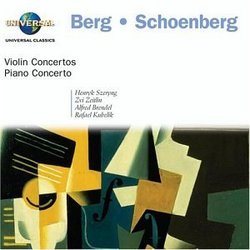| All Artists: Alban Berg, Arnold Schoenberg, Rafael Kubelik, Bavarian Radio Symphony Orchestra, Berlin Philharmonic Orchestra, Alfred Brendel Title: Berg: Violin Concerto; Schoenberg: Piano Concerto; Violin Concerto Members Wishing: 0 Total Copies: 0 Label: Umvd Labels Original Release Date: 1/1/2000 Re-Release Date: 1/13/2004 Genre: Classical Styles: Chamber Music, Forms & Genres, Concertos, Historical Periods, Classical (c.1770-1830), Modern, 20th, & 21st Century, Instruments, Keyboard, Strings Number of Discs: 1 SwapaCD Credits: 1 UPC: 028947484622 |
Search - Alban Berg, Arnold Schoenberg, Rafael Kubelik :: Berg: Violin Concerto; Schoenberg: Piano Concerto; Violin Concerto
 | Alban Berg, Arnold Schoenberg, Rafael Kubelik Berg: Violin Concerto; Schoenberg: Piano Concerto; Violin Concerto Genre: Classical
|
Larger Image |
CD Details |
CD ReviewsA Great Reissue at a Great Price! Sébastien Melmoth | Hôtel d'Alsace, PARIS | 01/30/2005 (5 out of 5 stars) ". This is an excellent disc--a reissue from the '70s--and as a bonus, it's at a great price. The Berg Concerto is great, and almost too popular: it's available in several performances. The Schoenberg Piano Concerto is also available in serveral realizations (e.g., Uchida; Brendel; Gould). It's one of the unpopular Schoenberg's most "popular" works because, though 12-tone in form, the row used is ambigously tonal. But the real star of this disc is the Schoenberg Violin Concerto. This is one of Schoenberg's most virtuosic pieces: it's stunningly well orchestrated, and the violin cadenzas are spectacular. It's a 12-tone piece, but makes no consessions to older tonalities. This is such a great piece that I often wonder why some of the great violinists of our time don't play it: Perlman, for example; or Mutter--who plays the heck out of the Berg Concerto. Too difficult perhaps, for Schoenberg joked that the soloist should have a sixth finger on his/her left hand to realize the piece! May 2008: STOP THE PRESSES...NEWS FLASH: Hilary Hahn shreds Schönberg's Violin Concerto! After working on this piece for about a decade, Ms. Hahn knows this work inside and out. Her brilliant realization is a new star in the firmament. Schoenberg Violin Concerto Op.36/Sibelius Violin Concerto Op.47 ." A historic CD Helmut Moritz | Graz, Austria | 09/11/2006 (5 out of 5 stars) "This CD is containing the three most important concertos of the "Second Vienna School" founded by Schoenberg in the first half of the 20th Century. The Violin Concerto by Alban Berg (1936) is certainly the best-known and the most often heard of the three. It is a remarkable synthesis of the classical harmonic style and the new twelve-tone style. It effortlessly merges quotations from Bach and Austrian tunes with the basically atonal structure into a beautiful and moving piece (a noble swan song indeed). The Schoenberg concertos are more difficult. Let us start with the Violin Concerto (1936) which is very seldom played and has a reputation of being abstract and inaccessible. If you do not yet know it, just listen to it a few times. The first time it may appear to be not much more than interesting noise. The second time you may catch one or two striking phrases or even melodies. The third and forth time the interesting phrases become more and more numerous and you start thinking that the piece may not be so bad at all. The fifth time you catch the structure, the melodies and harmonies, and the noise is gone. Wonderful music has remained. The same procedure applies to the Piano Concerto (1942), only that it is easier. Don't worry about twelve-tone music and atonality, just try listen to it as a normal piece of classical music. You will find that all three concertos are very fine pieces, basically in the romantic tradition, not much more difficult than, say, Mahler. The problem with "modern" music (the concertos have been written more than 60 years ago!) is that they are rarely played and (as all music) can be appreciated only after repeated listening. This is why this CD is so important. In fact, I already have the early vinyl recordings of the Piano Concerto by Glenn Gould, and of the Berg and Schoenberg Violin Concerto by Louis Krasner, who was the first to overcome the tremendous difficulties of the latter (Jascha Heifetz had returned the piece as unplayable!). The violinists of the present record (Henryk Szeryng and Zvi Zeitlin) are very fine musicians. The pianist, Alfred Brendel, lives up to his reputation as a poetic performer of romantic music, from Schubert to Liszt. Listening to their play, you will forget about virtuosity and hear only music of exquisite beauty. The orchestral colours are essential to this music. Rafael Kubelik is an inspiring conductor of the Bavarian Radio Symphony Orchestra. This record is unique. Helmut Moritz, Graz (Austria) " Perfect Pieces For The Twelve-Tone Beginner Michael Newman | Long Beach, CA | 04/08/2004 (5 out of 5 stars) "While I have not yet decided how I feel about twelve-tone music in general (some of it I like, and some (i.e. Webern and Boulez) I don't know if I'll ever understand), I LOVE the music on this CD. Berg's Violin Concerto is relatively "easy" to listen to (for a twelve-tone piece, that is) and is absolutely beautiful. It hovers on the edges of conventional tonality and features music of incredible intensity and loveliness. For this reason, it is, I think, a good place for the "twelve-tone beginner" to start listening to music of the twentieth century. Schoenberg's pieces on this CD are less accessible, but are also masterpieces. The piano concerto, in particular, is a remarkable work, and is well worth the repeated listening necessary to understand and appreciate it. Again, this is not easy music, but is music that will reward careful and concentrated listening."
|

 Track Listings (9) - Disc #1
Track Listings (9) - Disc #1